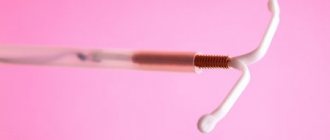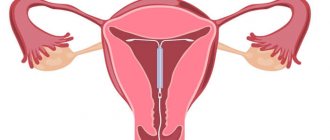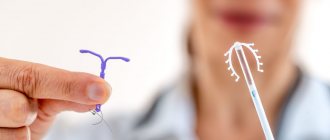Mirena is an intrauterine device, which is an entire hormonal system used in gynecology not only for contraceptive, but also for therapeutic purposes. Mirena for adenomyosis helps relieve concomitant symptoms, alleviate the patient’s condition, and stop the progression of pathological processes associated with uncontrolled growth of the endometrium.
Installation of the spiral is carried out only according to medical indications, because it has its own contraindications and side effects. The validity period of the drug is up to 5 years. After this period, the spiral is removed and, if necessary, a new one is installed. Before prescribing the Mirena coil to a patient, medical specialists will conduct a comprehensive diagnostic examination, which will help eliminate contraindications and avoid side effects.
In what cases is Mirena prescribed for adenomyosis?
Adenomyosis is a gynecological pathology in which the endometrium grows into the muscular layer of the uterus. The progression of the disease is accompanied by pathological symptoms, disruption of the reproductive system, and the inability to conceive and bear a child. Mirena for uterine adenomyosis helps stop the uncontrolled growth of the endometrium and relieve unpleasant symptoms.
The intrauterine device is installed only according to doctor's indications. The drug is recommended in the following cases:
Progressive internal adenomyosis, manifested by a pronounced clinical picture. A woman is worried about severe pain in the lower abdomen, heavy, prolonged menstrual bleeding, and discomfort during sexual intercourse.
- Uterine leimioma.
- Endometrial hyperplasia.
- Menstrual irregularities.
- Extensive damage by foci of adenomyosis of the myometrium.
- Heavy uterine bleeding, contributing to the development of iron deficiency anemia.
An intrauterine device is installed in women who have already given birth to a child. In exceptional situations, the drug is also used for nulliparous women, but in this case there is a high risk of prolapse of the system from the uterus. Before installation, the doctor sanitizes the vagina and cervix to make sure there are no active inflammatory processes. It is worth noting that after implantation, a woman will not be able to get pregnant for 5 years; this fact is also taken into account by the doctor before prescribing the drug.
Before installing Mirena®, pathological processes in the endometrium should be excluded, since irregular bleeding/spotting is often observed in the first months of its use. Pathological processes in the endometrium should also be excluded if bleeding occurs after starting estrogen replacement therapy in a woman who continues to use Mirena®, previously prescribed for contraception. Appropriate diagnostic measures must also be taken when irregular bleeding develops during long-term treatment.
Mirena® is not used for postcoital contraception.
Mirena® should be used with caution in women with congenital or acquired valvular heart disease, keeping in mind the risk of septic endocarditis. When inserting or removing an IUD, these patients should be given prophylactic antibiotics.
Levonorgestrel in low doses can affect glucose tolerance, and therefore its blood levels should be regularly checked in women with diabetes mellitus using Mirena®. As a rule, no dose adjustment of hypoglycemic drugs is required.
Some manifestations of polyposis or endometrial cancer may be masked by irregular bleeding. In such cases, additional examination is necessary to clarify the diagnosis.
Mirena® is not a first choice drug for young women who have never been pregnant, or for postmenopausal women with severe uterine atrophy.
Available data indicate that the use of Mirena® does not increase the risk of developing breast cancer in postmenopausal women under the age of 50 years. Due to the limited data obtained during the study of Mirena® for the indication “prevention of endometrial hyperplasia during estrogen replacement therapy,” the risk of breast cancer when using Mirena® for this indication cannot be confirmed or refuted.
Oligo- and amenorrhea. Oligo- and amenorrhea in women of fertile age develops gradually, in approximately 57 and 16% of cases by the end of the first year of using Mirena®. If menstruation is absent within 6 weeks after the start of the last menstrual period, pregnancy should be excluded. Repeated pregnancy tests for amenorrhea are not necessary if there are no other signs of pregnancy.
When Mirena® is used in combination with continuous estrogen replacement therapy, most women gradually develop amenorrhea over the first year.
Inflammatory diseases of the pelvic organs (PID). The guide tube helps protect Mirena® from infection during insertion, and the Mirena® delivery device is specially designed to minimize the risk of infection.
PID in patients using IUDs is often classified as a sexually transmitted disease. Having multiple sexual partners has been found to be a risk factor for PID. PID can have serious consequences: it can impair fertility and increase the risk of ectopic pregnancy.
As with other gynecologic or surgical procedures, severe infection or sepsis (including group A streptococcal sepsis) may develop after insertion of an IUD, although this is extremely rare. In case of recurrent endometritis or PID, as well as in severe or acute infections that are resistant to treatment for several days, Mirena should be removed. If a woman has persistent pain in the lower abdomen, chills, fever, pain associated with sexual intercourse (dyspareunia), prolonged or heavy spotting/bleeding from the vagina, or a change in the nature of vaginal discharge, you should consult your doctor immediately. Severe pain or fever that occurs soon after insertion of an IUD may indicate a serious infection that must be treated immediately. Even in cases where only individual symptoms indicate the possibility of infection, bacteriological examination and monitoring are indicated.
Expulsion. Possible signs of partial or complete expulsion of any IUD are bleeding and pain. Contractions of the uterine muscles during menstruation sometimes lead to the displacement of the IUD or even its expulsion from the uterus, which leads to the cessation of contraceptive action. Partial expulsion may reduce the effectiveness of Mirena®. Since Mirena® reduces menstrual blood loss, an increase in blood loss may indicate expulsion of the IUD. A woman is advised to check the threads with her fingers, for example while taking a shower. If a woman shows signs of the IUD being dislodged or falling out, or cannot feel the threads, she should avoid sexual intercourse or use other methods of contraception, and consult a doctor as soon as possible.
If the position in the uterine cavity is incorrect, the IUD must be removed. A new system may be installed at this time.
It is necessary to explain to the woman how to check the threads of Mirena®.
Perforation and penetration. Perforation or penetration of the body or cervix of the IUD occurs rarely, mainly during insertion, and may reduce the effectiveness of Mirena®. In these cases, the system should be removed. If there is a delay in diagnosing perforation and IUD migration, complications such as adhesions, peritonitis, intestinal obstruction, intestinal perforation, abscesses or erosions of adjacent internal organs may occur. The risk of uterine perforation is increased in women who are breastfeeding. There may be an increased risk of perforation when installing an IUD after childbirth and in women with a fixed uterine flexion.
Ectopic pregnancy. Women with a history of ectopic (ectopic) pregnancy, tubal surgery or pelvic infection are at higher risk of ectopic pregnancy. The possibility of ectopic pregnancy should be considered in the case of lower abdominal pain, especially if it is combined with cessation of menstruation, or when a woman with amenorrhea begins to bleed. The incidence of ectopic pregnancy when using Mirena® is approximately 0.1% per year. The absolute risk of ectopic pregnancy in women using Mirena® is low. However, if a woman with installed Mirena® becomes pregnant, the relative likelihood of ectopic pregnancy is higher.
Loss of threads. If, during a gynecological examination, the threads for removing the IUD cannot be detected in the cervical area, it is necessary to exclude pregnancy. The threads can be drawn into the uterine cavity or cervical canal and become visible again after the next menstruation. If pregnancy is ruled out, the location of the threads can usually be determined by careful probing with an appropriate instrument. If the threads cannot be detected, the IUD may have expelled from the uterine cavity. Ultrasound can be used to determine the correct placement of the system. If it is unavailable or unsuccessful, X-ray examination is used to determine the localization of Mirena®.
Ovarian cysts. Since the contraceptive effect of Mirena® is mainly due to its local action, women of fertile age usually experience ovulatory cycles with follicle rupture. Sometimes follicular atresia is delayed and follicular development may continue. Such enlarged follicles cannot be clinically distinguished from ovarian cysts. Ovarian cysts were reported as an adverse reaction in approximately 7% of women using Mirena®. In most cases, these follicles do not cause any symptoms, although sometimes they are accompanied by pain in the lower abdomen or pain during intercourse. As a rule, ovarian cysts disappear on their own within 2–3 months of observation. If this does not happen, it is recommended to continue monitoring with ultrasound, as well as therapeutic and diagnostic measures. In rare cases, it is necessary to resort to surgical intervention.
The use of Mirena® in combination with estrogen replacement therapy. When using Mirena® in combination with estrogens, it is necessary to additionally take into account the information specified in the instructions for use of the corresponding estrogen.
Excipients contained in Mirena®. The T-shaped base of Mirena® contains barium sulfate, which becomes visible during X-ray examination.
It must be borne in mind that Mirena® does not protect against HIV infection and other sexually transmitted diseases.
Additional information for patients
Regular inspections. The doctor should examine the patient 4–12 weeks after insertion of the IUD; thereafter, regular medical examinations are required at least once a year.
You should consult your doctor as soon as possible in the following cases:
- the patient stopped feeling the threads in the vagina;
- the patient can feel the lower end of the system;
- the patient assumes that she is pregnant;
- the patient feels constant abdominal pain, fever, or notes a change in the usual nature of vaginal discharge;
- the patient or her partner feels pain during sexual intercourse;
- the patient noted sudden changes in the menstrual cycle (for example, menstruation was scanty or absent, and then constant bleeding or pain appeared, or menstruation became excessively heavy);
- the patient has other medical problems, such as migraine-type headaches or severe recurring headaches, sudden changes in vision, jaundice, increased blood pressure, or any other diseases and conditions listed in the sections “Contraindications” and “Precautions”.
What to do if the patient wants to become pregnant or remove Mirena® for other reasons. The doctor can easily remove the IUD at any time, after which pregnancy becomes possible. Removal is usually painless. After removing Mirena®, reproductive function is restored.
When pregnancy is undesirable, Mirena® should be removed no later than the 7th day of the menstrual cycle. If Mirena® is removed later than the 7th day of the cycle, you should use barrier methods of contraception (for example, a condom) for at least 7 days before its removal. If there is no menstruation while using Mirena®, 7 days before removal of the IUD, you should start using barrier contraceptive methods and continue their use until menstruation resumes. You can also insert a new IUD immediately after removing the previous one; in this case, no additional measures to prevent pregnancy are required.
How long can you use Mirena®? Mirena® provides protection against pregnancy for 5 years, after which it should be removed. You can install a new IUD after removing the old one.
Restoring the ability to conceive (is it possible to get pregnant after stopping the use of Mirena®). Once Mirena® is removed, it no longer affects normal fertility. Pregnancy can occur during the 1st menstrual cycle after removing Mirena®.
Effect on the menstrual cycle (can Mirena® affect the menstrual cycle). Mirena® affects the menstrual cycle. Under its influence, menstruation may change and acquire the character of spotting, become longer or shorter, occur with more or less bleeding than usual, or stop altogether. In the first 3–6 months after installation of Mirena®, many women experience, in addition to their normal menstruation, frequent spotting or scanty bleeding. In some cases, very heavy or prolonged bleeding is observed during this period. If the patient experiences these symptoms, especially if they do not disappear, the doctor should be informed. It is most likely that when using Mirena®, the number of days of bleeding and the amount of blood lost will gradually decrease with each month. Some women eventually find that their periods have stopped completely. Since the amount of blood lost during menstruation usually decreases when using Mirena®, most women experience an increase in hemoglobin in the blood.
After the system is removed, the menstrual cycle returns to normal.
Lack of menstruation. Is it normal not to have menstruation when using Mirena®? If, after installing Mirena®, the patient noted the disappearance of menstruation, this is due to the effect of the hormone on the uterine mucosa. There is no monthly thickening of the mucous membrane, therefore, it is not rejected during menstruation. This does not necessarily mean that the patient has reached menopause or is pregnant. The concentration of own hormones in the blood plasma remains normal. In fact, not having periods can be a big benefit to a woman's comfort.
How can you find out about pregnancy. Pregnancy in women using Mirena®, even if they do not menstruate, is unlikely. If the patient has not had a menstrual period for 6 weeks and is concerned, a pregnancy test should be performed. If the result is negative, there is no need to do additional tests unless there are other signs of pregnancy, such as nausea, fatigue or breast tenderness.
Can Mirena® cause pain or discomfort. Some women experience pain (similar to menstrual cramps) in the first 2 to 3 weeks after having an IUD inserted. If the patient experiences severe pain or if the pain continues for more than 3 weeks after installation of the system, you should contact your doctor or the medical institution where Mirena® was installed.
Does Mirena® affect sexual intercourse? Neither the patient nor her partner should feel the IUD during sexual intercourse. Otherwise, sexual intercourse should be avoided until the doctor is sure that the system is in the correct position.
How much time should pass between the installation of Mirena® and sexual intercourse. It is best to abstain from sexual intercourse for 24 hours after inserting Mirena® into the uterus to give the body a rest. However, Mirena® has a contraceptive effect from the moment of installation.
Can I use tampons? It is recommended to use sanitary pads. If the patient uses tampons, they should be changed very carefully so as not to pull out the Mirena® threads.
What happens if Mirena® spontaneously leaves the uterine cavity. Very rarely, expulsion of the IUD from the uterine cavity may occur during menstruation. An unusual increase in blood loss during menstrual bleeding may mean that Mirena® has passed through the vagina. Partial expulsion of the IUD from the uterine cavity into the vagina is also possible (the patient and her partner may notice this during sexual intercourse). If Mirena® is completely or partially removed from the uterus, its contraceptive effect ceases immediately.
What signs can be used to judge that Mirena® is in place. The patient can independently check whether the Mirena® threads are in place after menstruation has ended. After your period ends, carefully insert your finger into the vagina and feel the threads at the end, near the entrance to the uterus (cervix). You should not pull the threads, because... You may accidentally pull Mirena® out of the uterus. If the patient cannot feel the threads, she should consult a doctor.
Impact on the ability to drive vehicles and machinery. Not observed.
The principle of operation of the hormonal intrauterine system
The Mirena therapeutic spiral contains the hormone levonorgestrel from the progesterone group. The hormone is enclosed in a special housing and protected by a membrane that regulates its release. Progestogen is released directly into the uterine cavity, affecting the functioning of the reproductive system.
The principle of operation of the hormonal intrauterine system:
- Reduces the sensitivity of receptors to specific hormones such as estrogen and progesterone.
- Makes the uterine mucosa immune to the female sex hormone estradiol.
- Prevents the growth of new pathological tissues.
Thanks to these medicinal properties, the coil for uterine adenomyosis helps to significantly improve the patient’s condition:
- Normalize the amount of menstrual flow, making it moderate.
- Eliminate pain and discomfort.
- Reduce the risk of uterine bleeding.
- Eliminate secondary anemia caused by excessive blood loss
Doctors' opinion
In addition to the contraceptive effect, doctors highlight the positive effect of the intrauterine device on the condition of the endometrium. Often, a contraceptive is prescribed for medicinal purposes during severe menopause, for the prevention of fibroids and endometriosis of the uterus. The spiral stops the growth of myomatous nodes, prevents cancer and endometrial hyperplasia, increases hemoglobin, and has a general strengthening effect. After removing Mirena, if you wish, you can become pregnant in the first year. Thanks to the action of hormones, it increases the level of fertility of a woman.
The Mirena intrauterine device is indeed a very convenient and practical means of contraception, however, given the considerable list of contraindications, special attention should be paid to examinations before installing a contraceptive. If you act according to the recommendations of specialists, there should be no health problems during contraception with the intrauterine system.
Benefits of using Mirena
During the conservative treatment of adenomyosis, various hormonal drugs are used, but Mirena has its own advantages:
- Installation is carried out once every 5 years. Unlike hormonal pills, which must be taken strictly according to schedule, after inserting an intrauterine device, a woman does not need to follow any rules or treatment regimens. The IUD remains effective throughout its stay in the body.
- Allows you to achieve a therapeutic effect with a minimal dosage of the hormone. The hormone levonorgestrel, which is part of the drug, enters directly into the uterine cavity, exerting a localized effect.
- Minimal risk of side effects. The drug does not pass through the digestive system, so it does not affect other internal organs.
- No risk of overdose. During the day, a strictly fixed dose of levonorgestrel is released - 20 mcg.
- Reliable contraception. After implantation of an intrauterine device, a woman is reliably protected from unwanted pregnancy.
- Normalization of hormonal levels.
Patients are often prescribed the drug Visanne for uterine adenomyosis. The active ingredient of the product is micronized dienogest - a synthetic hybrid gestagen of the third generation. The drug is available in tablet form and is used for internal and external endometriosis. The doctor must decide which is better - Visanne or Mirena for adenomyosis, taking into account the nature of the disease, the degree of neglect, the presence of indications and contraindications.
What is
The mechanism of action of the hormonal IUD is identical to other types of contraceptives. The drugs included in its composition kill sperm that have penetrated the uterine cavity, and also prevent the attachment of a fertilized egg to the walls of the uterus. The spiral may differ in its shape, material and composition. It is better to entrust the choice of a particular contraceptive to an experienced specialist.
On a note! It is worth noting that this type of intrauterine contraception does not protect a woman from sexually transmitted infections.
Disadvantages of the IUD
Like any other medication, the Mirena therapeutic system has its drawbacks, among which the most significant are:
- Installation and removal is carried out only by a doctor.
- Not suitable for women who are planning pregnancy in the near future.
- Has an abortifacient effect. The IUD does not always suppress ovulation, so conceiving a child is possible. But the pregnancy is terminated not yet in the early stages, since the implantation process is disrupted and a miscarriage occurs.
- Long adaptation period. In the first 3 to 6 months after IUD implantation, you may experience intermenstrual bleeding, which is normal.
- When installing an IUD, the risk of infection entering the uterine body increases.
- It is rare, but it happens that the drug leads to the progression of an aseptic inflammatory process in the reproductive organ.
Pharmacokinetics
Absorption.
After administration of the drug Mirena®, levonorgestrel begins to be immediately released into the uterine cavity, as evidenced by measurements of its concentration in the blood plasma. The high local exposure of the drug in the uterine cavity, necessary for the local effect of Mirena® on the endometrium, provides a high concentration gradient in the direction from the endometrium to the myometrium (the concentration of levonorgestrel in the endometrium exceeds its concentration in the myometrium by more than 100 times) and low concentrations of levonorgestrel in plasma blood (the concentration of levonorgestrel in the endometrium exceeds its concentration in the blood plasma by more than 1000 times).
Rate of release of levonorgestrel into the uterine cavity in vivo
initially is approximately 20 mcg/day, and after 5 years it decreases to 10 mcg/day.
Distribution.
Levonorgestrel binds nonspecifically to plasma albumin and specifically to SHBG. About 1–2% of circulating levonorgestrel is present as the free steroid, whereas 42–62% is specifically bound to SHBG. During use of the drug Mirena®, the concentration of SHBG decreases. Accordingly, the fraction associated with SHBG during the period of use of Mirena® decreases, and the free fraction increases. The average apparent Vd of levonorgestrel is about 106 L.
After administration of Mirena®, levonorgestrel is detected in the blood plasma an hour later. Cmax is achieved 2 weeks after administration of Mirena®. Consistent with the decreasing release rate, the median plasma concentration of levonorgestrel in women of reproductive age weighing more than 55 kg decreases from 206 pg/ml (25–75th percentile: 151–264 pg/ml) determined at 6 months to 194 pg/ml (146-266 pg/ml) - after 12 months and up to 131 pg/ml (113-161 pg/ml) - after 60 months.
Body weight and plasma SHBG concentrations have been shown to influence systemic levonorgestrel concentrations, i.e. with low body weight and/or high SHBG concentrations, levonorgestrel concentrations are higher. In women of reproductive age with low body weight (37–55 kg), the median plasma concentration of levonorgestrel is approximately 1.5 times higher.
In postmenopausal women using Mirena® simultaneously with the use of estrogens intravaginally or transdermally, the median concentration of levonorgestrel in the blood plasma decreases from 257 pg/ml (25–75th percentile: 186–326 pg/ml), determined after 12 months, up to 149 pg/ml (122–180 pg/ml) - after 60 months. When using Mirena® simultaneously with oral administration of estrogens, the concentration of levonorgestrel in the blood plasma, determined after 12 months, increases to approximately 478 pg/ml (25–75th percentile: 341–655 pg/ml), which is due to the induction of SHBG synthesis.
Biotransformation.
Levonorgestrel is extensively metabolized.
The main metabolites in blood plasma are unconjugated and conjugated forms of 3α, 5β-tetrahydrolevonorgestrel. Based on the results of in vitro
and
in vivo studies,
the main isoenzyme involved in the metabolism of levonorgestrel is CYP3A4. The isoenzymes CYP2E1, CYP2C19 and CYP2C9 may also be involved in the metabolism of levonorgestrel, but to a lesser extent.
Elimination.
The total plasma clearance of levonorgestrel is approximately 1 ml/min/kg. Unchanged levonorgestrel is excreted only in trace amounts. Metabolites are excreted through the intestines and kidneys with an excretion coefficient of approximately 1.77. T1/2 in the terminal phase, represented mainly by metabolites, is about a day.
Linearity/nonlinearity.
The pharmacokinetics of levonorgestrel depends on the concentration of SHBG, which, in turn, is influenced by estrogens and androgens. When using the drug Mirena®, a decrease in the average concentration of SHBG by approximately 30% was observed, which was accompanied by a decrease in the concentration of levonorgestrel in the blood plasma. This indicates the nonlinearity of levonorgestrel pharmacokinetics over time. Given the predominantly local effect of Mirena®, the effect of changes in systemic concentrations of levonorgestrel on the effectiveness of Mirena® is unlikely.
Scheme for using a hormonal IUD
Before inserting an intrauterine device, simple preparation is required, including the following steps:
- Initial examination by a doctor. During the procedure, the gynecologist assesses the general condition of the patient’s genital tract and excludes contraindications for the use of the drug.
- Testing for sexually transmitted infections. Laboratory procedures such as bacterial culture and survey smear will help identify possible problems. If necessary, tests for viral and intracellular infection are prescribed - PCR, ELISA.
- Ultrasound of the pelvic organs. Ultrasound examination helps to assess the condition of the uterus and appendages, diagnose concomitant pathologies, and determine the degree of progression of adenomyosis.
If there are no contraindications to the insertion of an intrauterine device, the doctor will agree on the date and time of the procedure. The Mirena hormonal system is installed on the 3rd – 7th day of the cycle - at the end of menstruation. During this period, the cervix is dilated, which allows the IUD to be inserted inside without hindrance.
The technology for maintaining the Mirena therapeutic system includes the following stages:
- Control examination and treatment of the genital mucosa with an antiseptic solution.
- Introduction of the mirror.
- Grasp the upper lip of the cervix with special gynecological forceps.
- Checking the patency of the cervical canal and the depth of the uterine cavity with a probe.
- Insertion of a guidewire and an intrauterine device through it.
- Removing the conductor.
After the guide is removed, the IUD remains in the uterus. All manipulations are carried out under ultrasound control, which significantly reduces the risk of side effects. After 5 years the sprial will need to be removed. Premature removal of the system is carried out in the following situations:
- development of unwanted side effects;
- complications arising from the installed IUD;
- pregnancy planning.
Removing the spiral
The removal of hormonal contraceptives is also carried out by a doctor. The device can be removed on any day of your period (provided you have a regular menstrual cycle). To do this, special pliers are used that grab its threads and carefully remove it. If the device was removed due to its expiration date, a new intrauterine contraceptive device can be installed on the same day.
If the IUD is removed outside of menstruation, then 7 days before this procedure you must start using other barrier methods of contraception.
When the Mirena IUD is removed, your doctor should check its integrity to ensure that all components have been successfully removed.
After the IUD is removed, the ability to become pregnant is restored almost immediately. Only in rare cases may this take time (up to six months).
Side effects and contraindications
After installation of the Mirena therapeutic system, side effects rarely develop, but they are still possible. Among the most common complications are the following:
- Individual intolerance to the drug, accompanied by pathological reactions and deterioration in general well-being.
- Frequent headaches, nausea, depressed mood, decreased libido.
- Periodic abdominal pain, bloating.
- Sudden jumps in blood pressure.
- Infections of organs located in the abdominal cavity.
- Failure of the menstrual cycle, manifested by a prolonged absence of menstruation.
Against the background of an implanted intrauterine device, the condition of the skin may worsen. Blackheads, acne, and inflammation appear on the face and body. In extremely rare cases, after the installation of an IUD, cysts form in the myometrium.
The Mirena therapeutic system is not prescribed to patients with suspected pregnancy. In this case, the woman must undergo tests to make sure there is no conception. Also, the IUD is contraindicated for implantation if the following pathologies are diagnosed:
- neoplasms of a malignant nature;
- uterine fibroids larger than 5 cm;
- inflammatory processes in the organs of the genitourinary system;
- congenital or acquired immunodeficiency;
- uterine bleeding of unknown etiology;
- individual intolerance to the active component of the drug.
Indications for use
The main indication for the use of an intrauterine device is considered to be the prevention of pregnancy. However, it should be borne in mind that during sexual intercourse it does not protect against STDs, so this type of contraception is not suitable for women who are prone to casual sexual intercourse and chronic infectious pathologies.
Often, an intrauterine device is used for intense menstrual flow for unknown reasons, having previously ruled out possible malignant formations in the organs of the reproductive system. Due to its action, Mirena is prescribed as a prophylaxis against endometrial hyperplasia, fibroids, and during severe menopause.
Complications associated with IUD insertion
During installation of an intrauterine device, there is a risk of developing the following complications:
- Perforation of the uterus. Injury leads to heavy bleeding and a sharp deterioration of the condition. Perforation mainly occurs due to deformation of the reproductive organ or congenital developmental anomalies.
- Expulsion of the system. If the coil falls out, you need to consult a doctor who will replace the drug.
- Endometritis. The main cause is an untreated genital tract infection.
- Ectopic pregnancy.
- Follicular atresia. After implantation of the IUD, the hormonal background changes, so the maturation of the egg is possible, but the follicle does not always mature completely. It increases in size and becomes similar to an ovarian cyst. Often, such a follicle resolves on its own within 2.5 – 3 months. If this does not happen, the patient's treatment plan changes.
Drug interactions
The metabolism of gestagens may be enhanced by the simultaneous use of substances that are enzyme inducers, especially cytochrome P450 isoenzymes involved in the metabolism of drugs, such as anticonvulsants (for example, phenobarbital, phenytoin, carbamazepine) and drugs for the treatment of infections (for example, rifampicin, rifabutin, nevirapine, efavirenz ). The effect of these drugs on the effectiveness of Mirena® is unknown, but it is believed that it is insignificant since Mirena® has mainly local effects.









